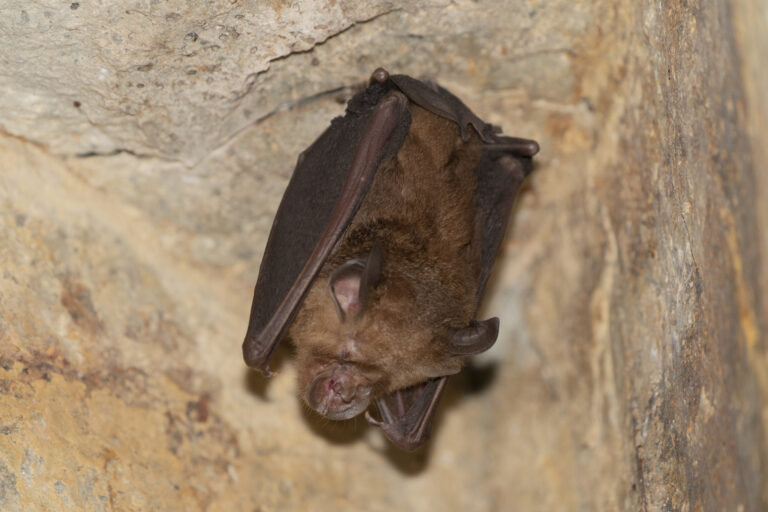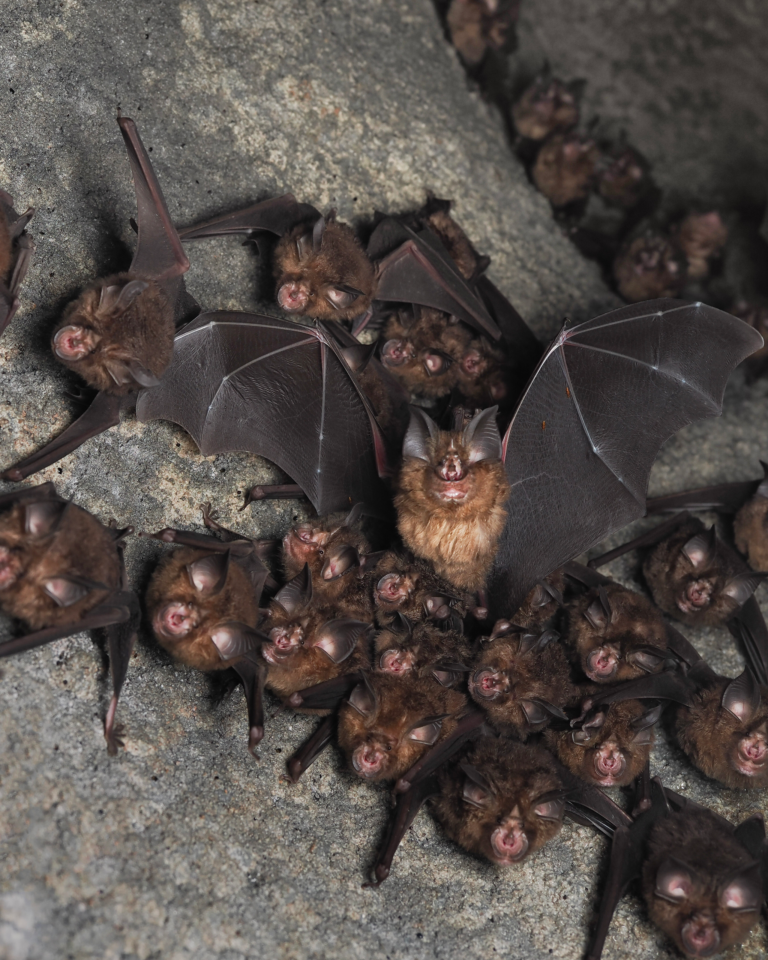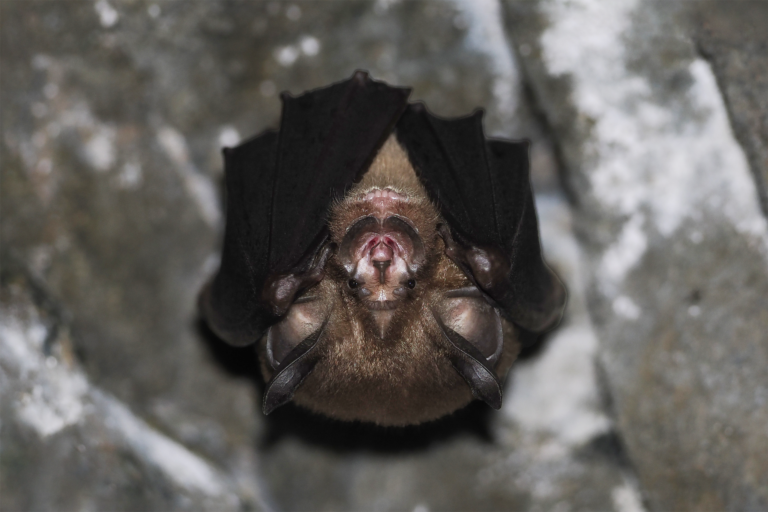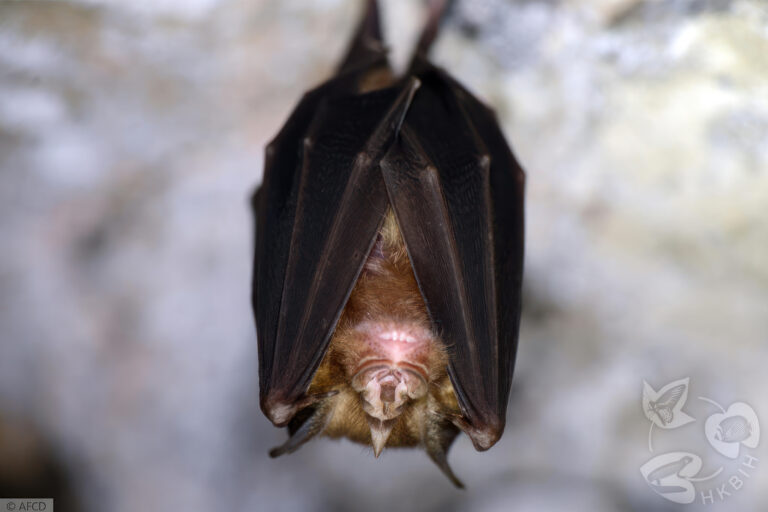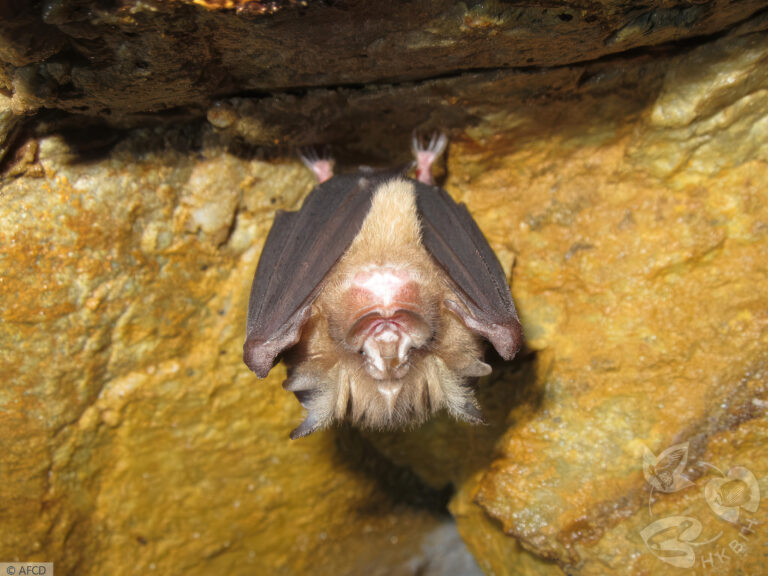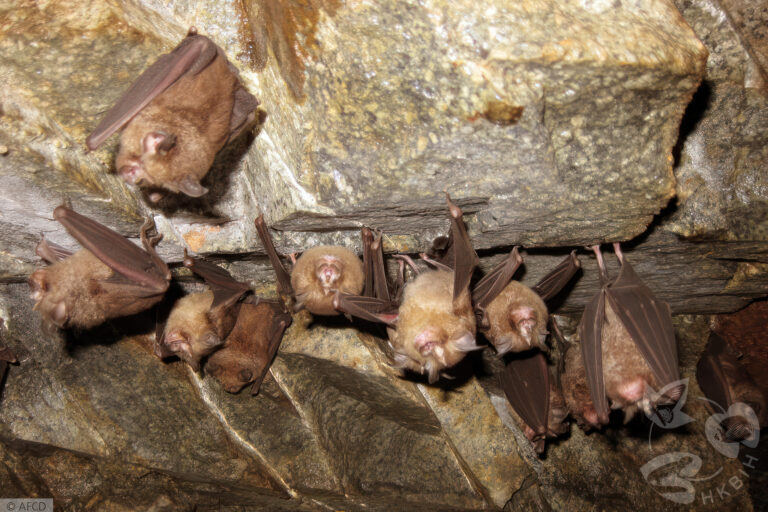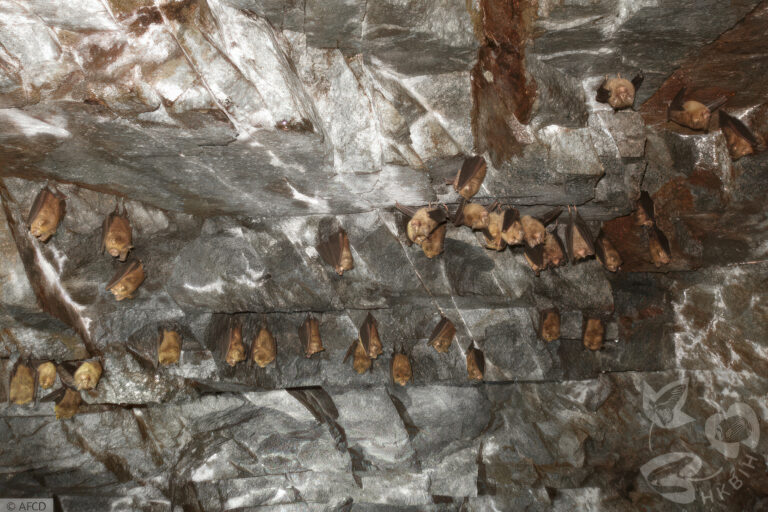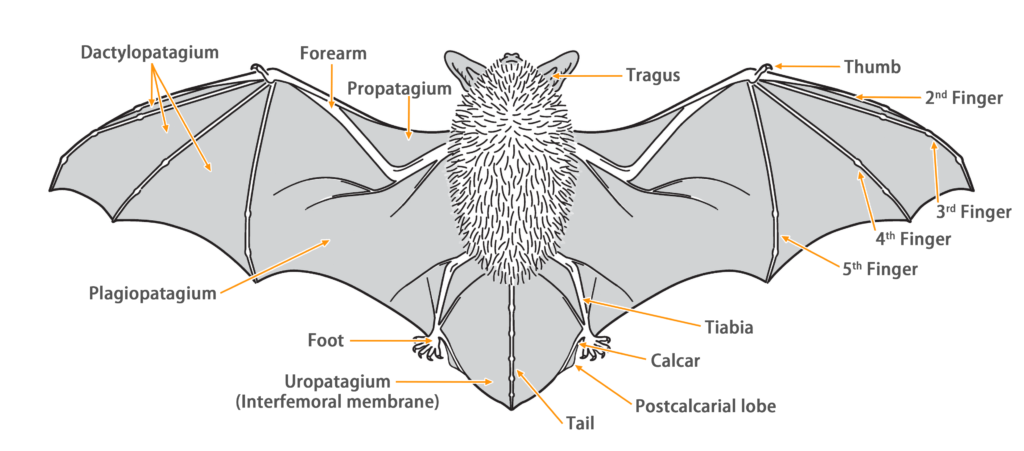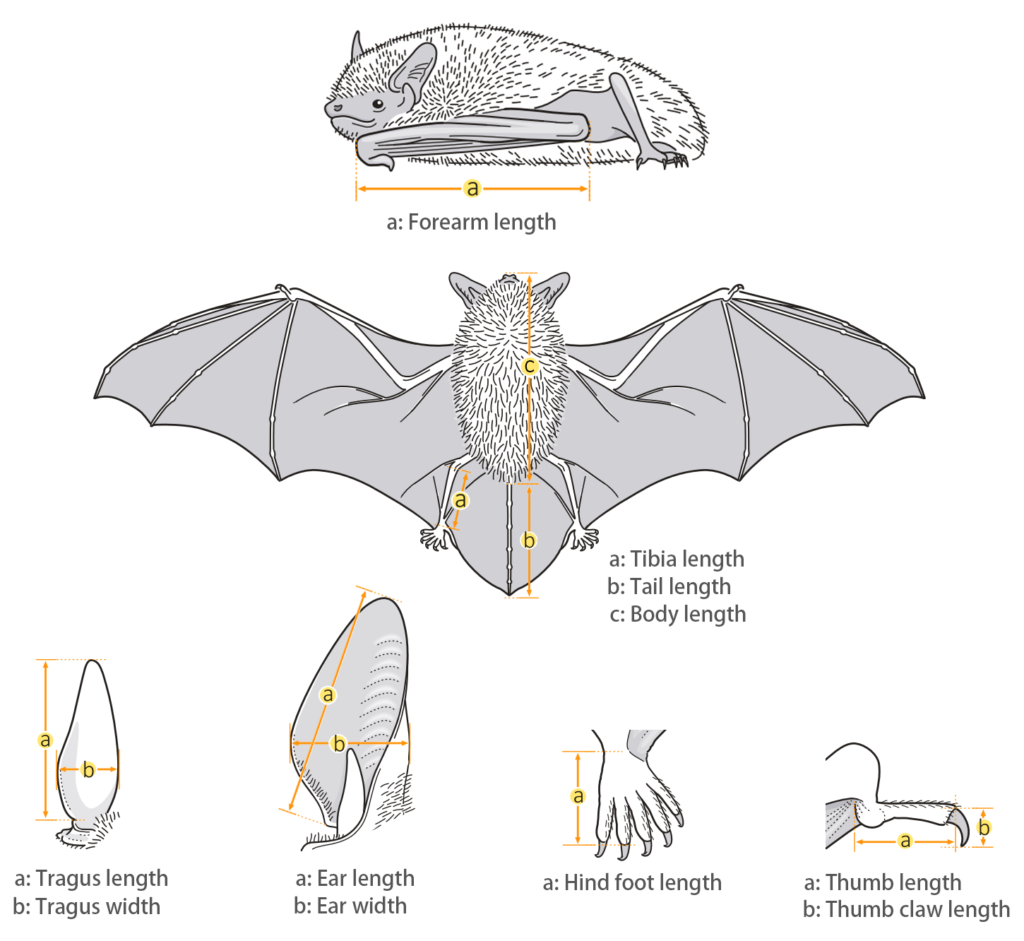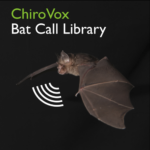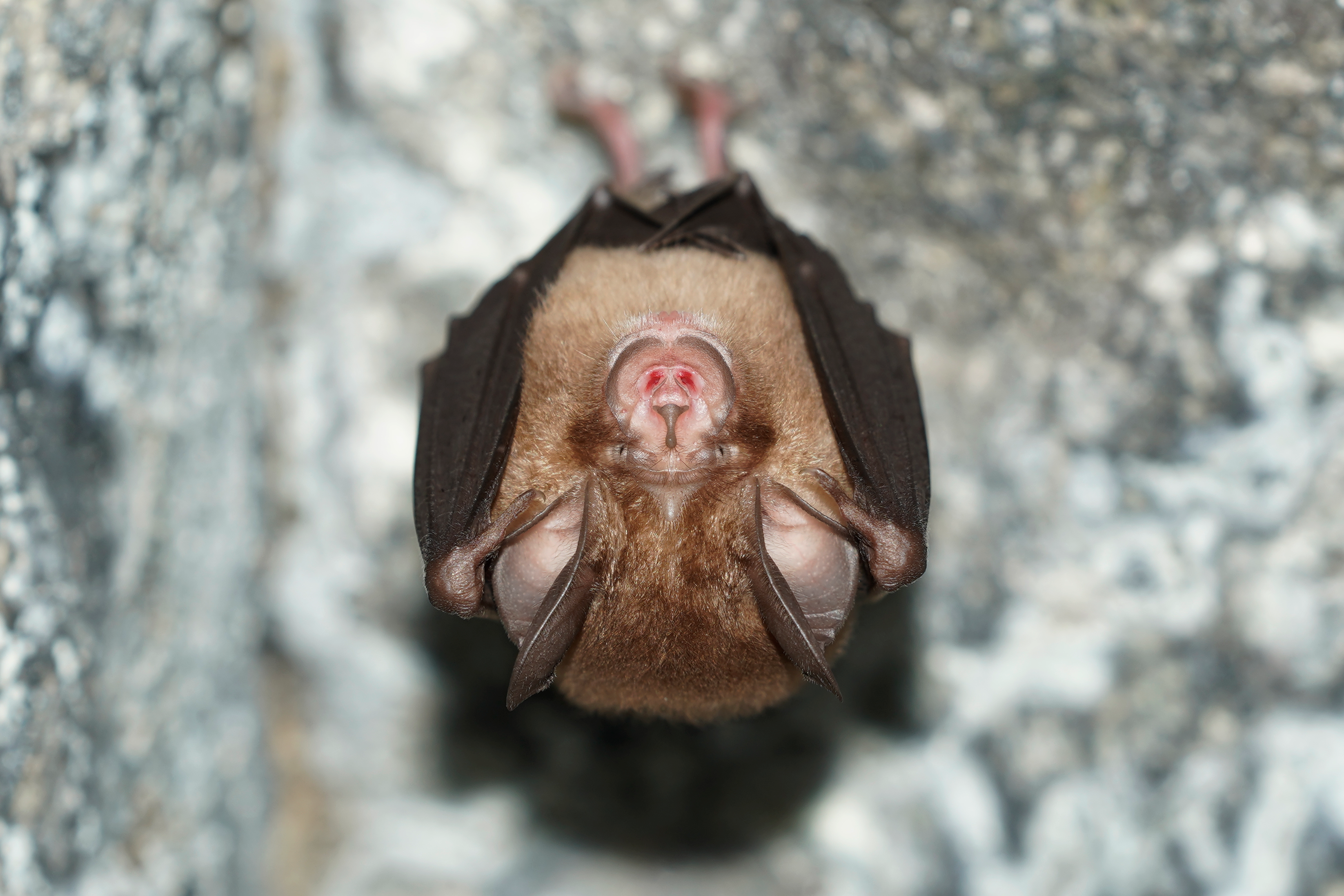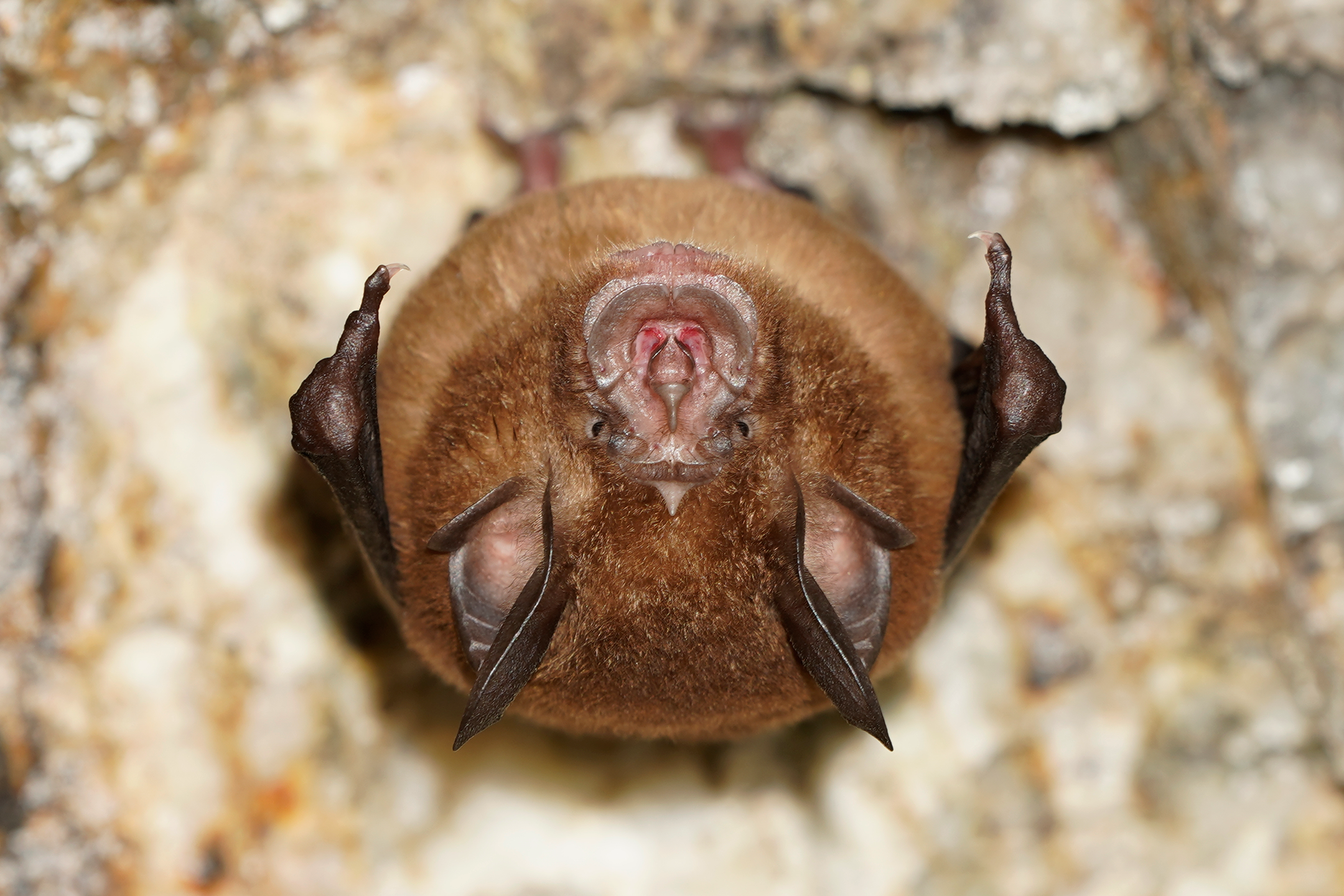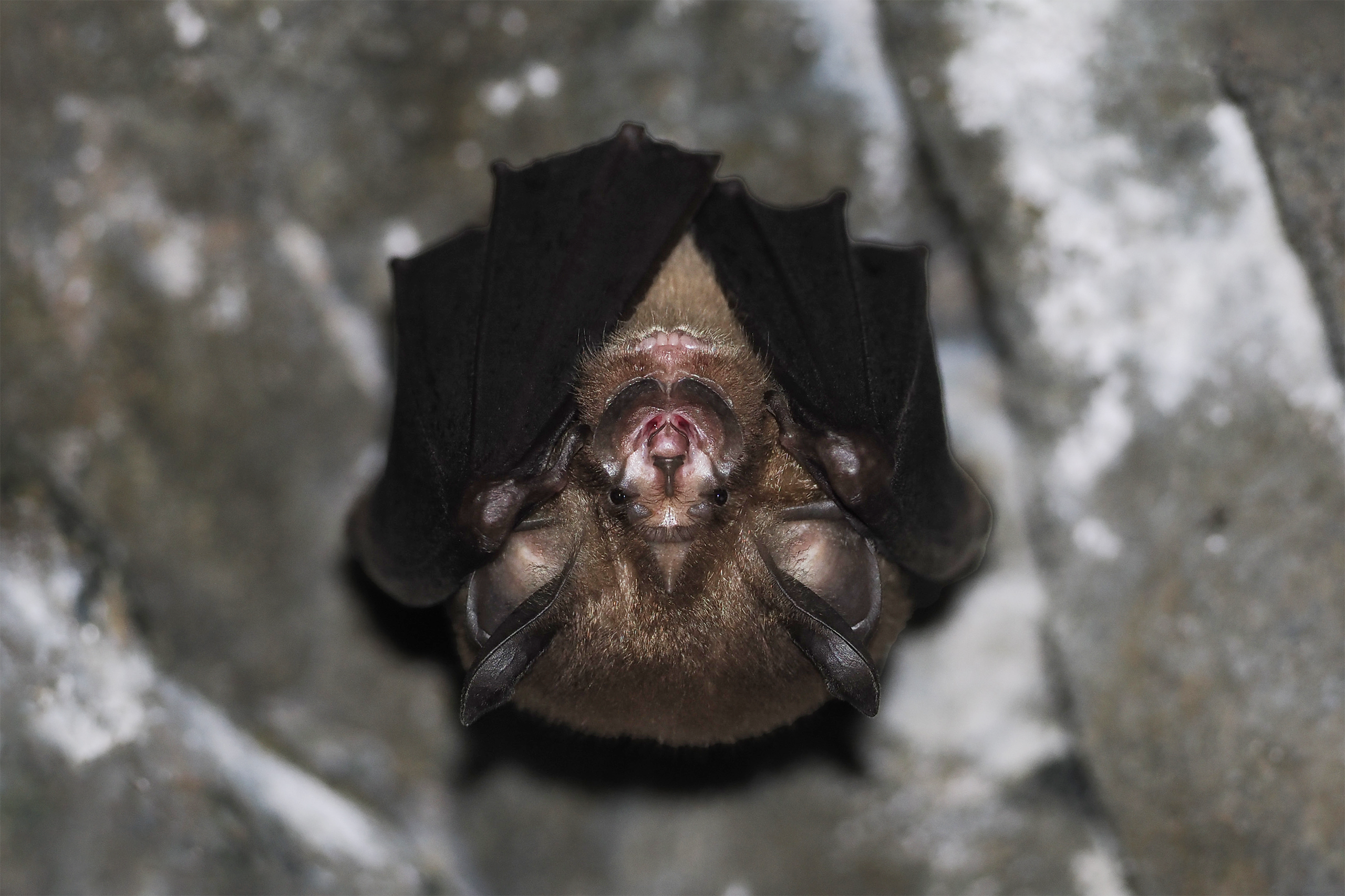- Hong Kong Bat Radar
- Intermediate Horseshoe Bat (Rhinolophus affinis)
Intermediate Horseshoe Bat
Rhinolophus affinis Horsfield, 1823
Taxonomy
| Family: | Rhinolophidae |
| Genus: | Rhinolophus |
| Scientific name: | Rhinolophus affinis Horsfield, 1823 |
| Synonyms: |
R. hainanus Allen, 1906, R. andamanensis Dobson, 1872, R. himalayanus Andersen, 1905, R. macrurus Andersen, 1905, R. nesites Andersen, 1905, R. princeps Andersen, 1905, R. superans Andersen, 1905, R. tener Andersen, 1905 |
| Common name: | Intermediate Horseshoe Bat |
| Other name: | - |
| Remark: | R. affinis includes six known sub-species: R. a. afinis (Horsfield, 1823), R. a. hainanus (J. A. Allen, 1906), R. a. himalayanus (K. Andersen, 1905), R. a. macrurus (K. Andersen, 1905), R. a. nesites (K. Andersen, 1905), R. a. princeps (K. Andersen, 1905). According to geographic distribution, the local species is R. a. macrurus. |
| Characteristics | |
| Color: | Dorsal pelage varies from brownish-yellow to dark brown; ventral pelage is relatively light; the color of juvenile is relatively darker (gray-black) |
| Ear: | Broad pinna with rounded outer edge and pointed end; wide and short antitragus, pinna and tragus are dark gray to gray black |
| Head: | Small eyes; relatively long triangular lancet with a pointed and slightly bending forward tip and concave outer edges; connecting process is rounded and sparsely haired; sella is slightly concave and pandurate in shape; horseshoe leaves are relatively broad (8.0 – 11.4 mm) |
| Mouth: | Lower lip has 3 mental grooves |
| Limbs: | Wings are attached to the ankle |
| Tail: | Long and enclosed by tail membrane |
| Body measurements | |
| Size: | Large horseshoe bat |
| Body: | 46.0 - 68.0 mm |
| Tail: | 17.4 - 35.0 mm |
| Ears: | 14.0 - 25.0 mm |
| Hind foot: | 9.8 - 13.0 mm |
| Forearm: | 46.0 - 57.0 mm |
| Weight: | 9.9 - 19.0 mm |
| Wing morphology | |
| Wing span: | 0.315 m |
| Wing area: | 0.019 m2 |
| Wing loading: |
7.20 ± 0.82 N/m2 (Low) |
| Aspect ratio: | 5.14 ± 0.34 (Low-Mid) |
| Tip-shape index: | 1.41 ± 0.31 (High) |
| Refernce: | Furey & Racey, 2016 |
Ecology
| Habitat: | Cave-dwelling bat typically inhabits temperature-stable water tunnels, abandoned mine caves, and also able to reside in crevices and hollow trees. |
| Habit: | This species is known to exhibit gregarious behavior, although solitary individuals can also be observed. Group sizes can reach over 1,000 individuals, with the Shiyan Cave colony in Jiangxi, China, estimated to have around 1,500 individuals. However, local colonies tend to be smaller, ranging from a few individuals to about a hundred. When roosting in groups, individuals generally maintain a small distance between each other, but at times they may huddle closely together. During winter, some individuals may gather around the hibernation colonies of the Chinese Horseshoe Bat. |
| Reproduction: | The mating season occurs from November to December, while the breeding season is from May to June. Females give birth to single young. |
| Hibernation: | Hibernate from late December to February but the actual hibernation period varies according to the prevailing temperature and weather patterns. |
| Flight: | This species exhibits a relatively slow flight speed and lower flight efficiency. However, it demonstrates excellent agility and moderate aerial hovering capabilities, making it well-suited for short-distance flights. |
| Foraging: | This species is classified as strictly nocturnal, typically departing from roosting sites within approximately 15 minutes after sunset and returning to the roosting site about 30 minutes before sunrise. It exhibits a preference for low-level flight, often navigating and foraging between tree trunks, dense vegetation, forest trails, or streams at altitudes of approximately 1.6 to 2 meters above the ground. Occasionally, it may hang on foliage for resting or waiting for prey. |
| Diet: | As insectivorous bats, they employ various methods to capture prey, including aerial feeding, gleaning and flycatching. They have a preference for feeding on insects from the orders Coleoptera, Lepidoptera, and Diptera. |
Diet composition of R. affinis in China (Jiangxi) (Jiang et al., 2013)
Diet composition of R. affinis in China (Yunnan) (Dai et al., 2023)
Distribution
| Local: | New Territory, Hong Kong Island and Lantau Island |
| Global: | |
| R. a. affinis : | Malay Peninsula (including Langkawi and Tioman Islands), Sumatra, North Pagai Island in Mentawai Islands, and Java; |
| R. a. hainanus : | Hainan Island, China; |
| R. a. himalayanus : | North India (Uttarakhand, Uttar Pradesh, Sikkim, West Bengal, Assam, Meghalaya, Arunachal Pradesh, and Nagaland), Nepal, Bhutan, Northeast Bangladesh, North Myanmar, and Central & South China (Sichuan, Yunnan, Shaanxi, Hubei, Hunan, and Guizhou); |
| R. a. macrurus : | Southeast China (Jiangsu, Anhui, Zhejiang,Jiangxi, Fujian, Guangdong, Hong Kong, and Guangxi), South Myanmar, Thailand, Laos, and Vietnam (including Dao Tra Ban and Phu Quoc Island); possibly also Cambodia; |
| R. a. nesites : | Borneo (including Laut, Sebuku, and Laut Kecil Islands) and Anamba and Natuna Islands; |
| R. a. princeps : | Kangean (Kangean and Sepanjang Islands), Lombok, Sumbawa, Flores, and Sumba Islands. (Csorba et al., 2019) |
Local distribution map
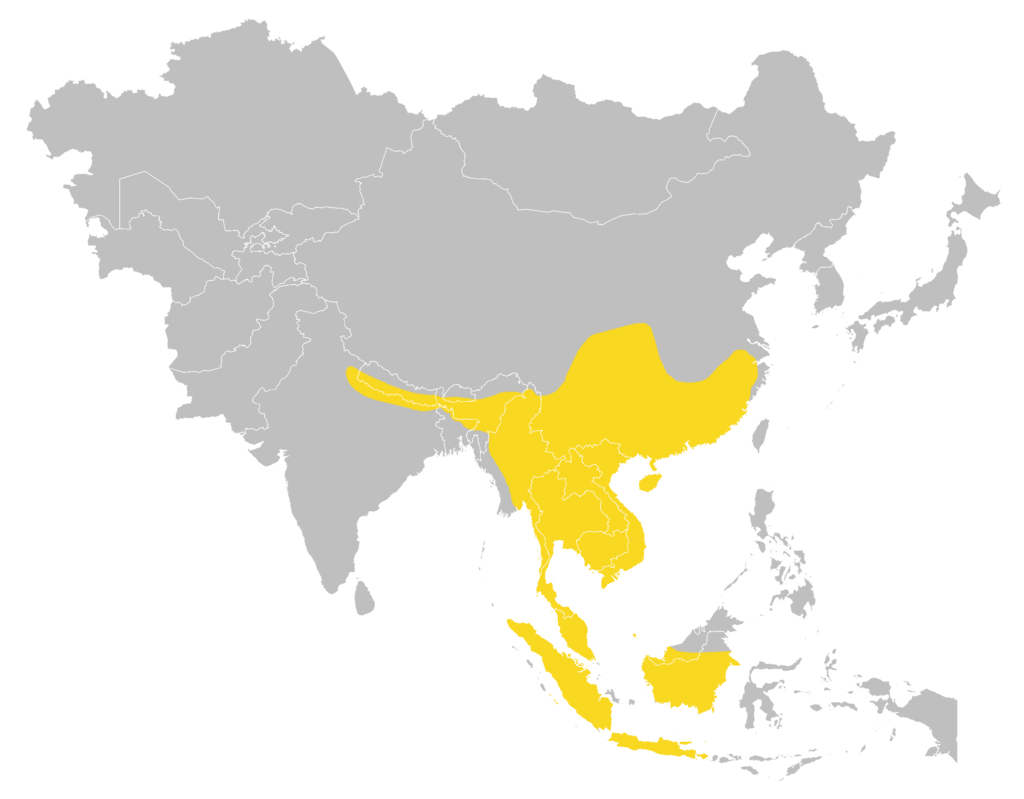
Global distribution map
(Csorba et al., 2019)
Status and Conservation
| First record: | 1964 |
| Origin: | Native |
| Local status: | Uncommon (Shek & Chan, 2005) |
| National status: | Least Concern (Red List of China Vertebrates) |
| Global status: | Least Concern (IUCN Red List) |
| Potential threat: | TBC |
Echolocation

| Parameter | Value |
|---|---|
| Call structure | aFM-CF-dFM |
| Duration | 38.3 (12.3 - 61.3) ms |
| Inter pulse interval | 73.6 (22.3 - 98.7) ms |
| Peak frequency | 72.0 (70.1 - 73.9) kHz |
| Highest frequency | - kHz |
| Lowest frequency | 52.6 (39.0 - 61.9) kHz |
|
Subspecies: |
R. a. macrurus |
|
Region: |
Hong Kong |
| Method: | Hand release / Wild Call |
| Reference: | Shek & Lau, 2006 |
| Parameter | Value |
|---|---|
| Call structure | aFM-CF-dFM |
| Duration | - ms |
| Inter pulse interval | - ms |
| Peak frequency | - kHz |
| Highest frequency | - kHz |
| Lowest frequency | - kHz |
|
Subspecies: |
R. a. macrurus |
|
Region: |
Hong Kong |
| Method: | Hand release |
| Reference: | TBC |
Similar Species
Least Horseshoe Bat
Rhinolophus pusillus
Size:
The smallest among the three.
Color:
Varies from brownish-yellow to dark brown
Lancet:
Triangular in shape with equal sides or elongated, with concave sides and a rounded blunt tip.
Connecting process:
Triangular in shape, pointing forward at the tip.
Sella:
Slightly concave on both sides, and pandurate in shape
Posture:
At rest, typically face the wall, keeping their bodies as close to the wall as possible. The wings are slightly open, covering the abdomen.
Habit:
Generally scattered in their habitat. When in groups, individuals tend to maintain a small distance between each other.
Chinese Horseshoe Bat
Rhinolophus sinicus
Size:
Intermediate between the intermediate and least horseshoe bats
Color:
Generally more vibrant, ranging from orange, rusty yellow to brownish-yellow in color.
Lancet:
Short triangular shape with a sharp tip and concave sides.
Connecting process:
Smooth and rounded on the sides.
Sella:
Parallel sides, round and without concavities, with a rounded blunt end.
Posture: At rest, the wings are usually folded and held on both sides, exposing the abdomen.
Habit:
When in groups, they form colonies with a moderate level of density and closeness.
Intermediate Horseshoe Bat
Rhinolophus affinis
Size:
The largest among the three.
Color:
Varies from brownish-yellow to dark brown
Lancet:
Long and pointed triangular shape, with a sharp and slightly forward-curved tip, and concave sides.
Connecting process:
Smooth and rounded on the sides.
Sella:
Parallel sides, with a flat and slightly concave end in the center.
Posture:
At rest, the wings are slightly open, covering the abdomen.
Habit:
When in groups, individuals usually maintain a small distance between each other.
Bibliography
Csorba, G., Hutson, A., Rossiter, S., & Burgin, C. (2019). Hipposideridae. In Mittermeier, R. A., & Wilson, D. E. (Eds.), Handbook of the Mammals of the World – Volume 9 Bats (pp. 280-332). Lynx Edicions.
Dai, W., Li, A., Chang, Y., Liu, T., Zhang, L., Li, J., Leng, H., Li, Z., Jin, L., Sun, K. & Feng, J. (2023). Diet composition, niche overlap and partitioning of five sympatric rhinolophid bats in Southwestern China during summer. Frontiers in Ecology and Evolution, 11, 1108514.
Furey, N. M., & Racey, P. A. (2016). Can wing morphology inform conservation priorities for Southeast Asian cave bats?. Biotropica, 48(4), 545-556.
Jiang, T., Feng, J., Sun, K., & Wang, J. (2008). Coexistence of two sympatric and morphologically similar bat species Rhinolophus affinis and Rhinolophus pearsoni. Progress in Natural Science, 18(5), 523-532.
Jiang, T., Lu, G., Sun, K., Luo, J., & Feng, J. (2013). Coexistence of Rhinolophus affinis and Rhinolophus pearsoni revisited. Acta Theriologica, 58, 47-53.
Jiang, Z. G., Jiang, J. P., Wang, Y. Z., Zhang, E., Zhang, Y. Y., Li, L. L., Xie, F., Cai, B., Cao, L., Zheng, G. M., Dong, L., Zhang, Z. W., Ding, P., Luo, Z. H., Ding, C. Q., Ma, Z. J., Tang, S. H., Cao, W. X., Li, C. W., Hu, H. J., Ma, Y., Wu, Y., Wang, Y. X., Zhou, K. Y., Liu, S. Y., Chen, Y. Y., Li, J. T., Feng, Z. J., Wang, Y., Wang, B., Li, C., Song, X. L., Cai, L., Zang, C. X., Zeng, Y., Meng, Z. B., Fang, H. X., & Ping, X. G. (2016). Red List of China’s Vertebrates. Biodiversity Science 24(5), 500‑551.
Mao, X., Tsagkogeorga, G., Thong, V. D., & Rossiter, S. J. (2019). Resolving evolutionary relationships among six closely related taxa of the horseshoe bats (Rhinolophus) with targeted resequencing data. Molecular phylogenetics and evolution, 139, 106551.
Shek, C. T. (2006). A Field Guide to the Terrestrial Mammals of Hong Kong. Friends of country park and cosmos book limited.
Shek, C. T., & Chan, C. S. M. (2005). Roost Censuses of Cave Dwelling Bats of Hong Kong. Hong Kong Biodiversity, 10, 1-8.
Shek, C. T., & Lau, C. T. Y. (2006). Echolocation Calls of Five Horseshoe Bats of Hong Kong. Hong Kong Biodiversity, 13, 9-12.
Shen, Q. Q. (2015). Geographical variation in echolocation calls of four horseshoe bats. [Master’s dissertation, East China Normal University].
Thong, V. D., Denzinger, A., Sang, N. V., Huyen, N. T. T., Thanh, H. T., Loi, D. N., Nha, P. V., Viet, N. V., Tien, P. D., Tuanmu, M.-N., Huang, J. C.-C., Thongphachanh, L., Luong, N. T.,& Schnitzler, H. U. (2021) Bat Diversity in Cat Ba Biosphere Reserve, Northeastern Vietnam, A Review with New Records from Mangrove Ecosystem. Diversity, 13(8), 376.
Thomas, N. M. (2000). Morphological and mitochondrial-DNA variation in Rhinolophus rouxii (Chiroptera). Bonner Zoologische Beiträge, 49, 1-18.
Tong, C. P. (2016). Distribution and preference of landscape features and foraging sites of insectivorous bats in Hong Kong urban parks. [Master’s dissertation, The University of Hong Kong].
Ye, G. X., Shi, L. M., Sun, K. P., Zhu, X., & Feng, J. (2009). Coexistence mechanism of two sympatric horseshoe bats (Rhinolophus sinicus and Rhinolophus affinis)(Rhinolophidae) with similar morphology and echolocation calls. Acta Ecologiva Sinica, 29(10), 5330-5338.
Hong Kong Bat Radar. (01/05/2024). A Field Guide to Bats of Hong Kong: Intermediate Horseshoe Bat (Rhinolophus affinis ). https://hkbatradar.com/en/rhinolophus_affinis

